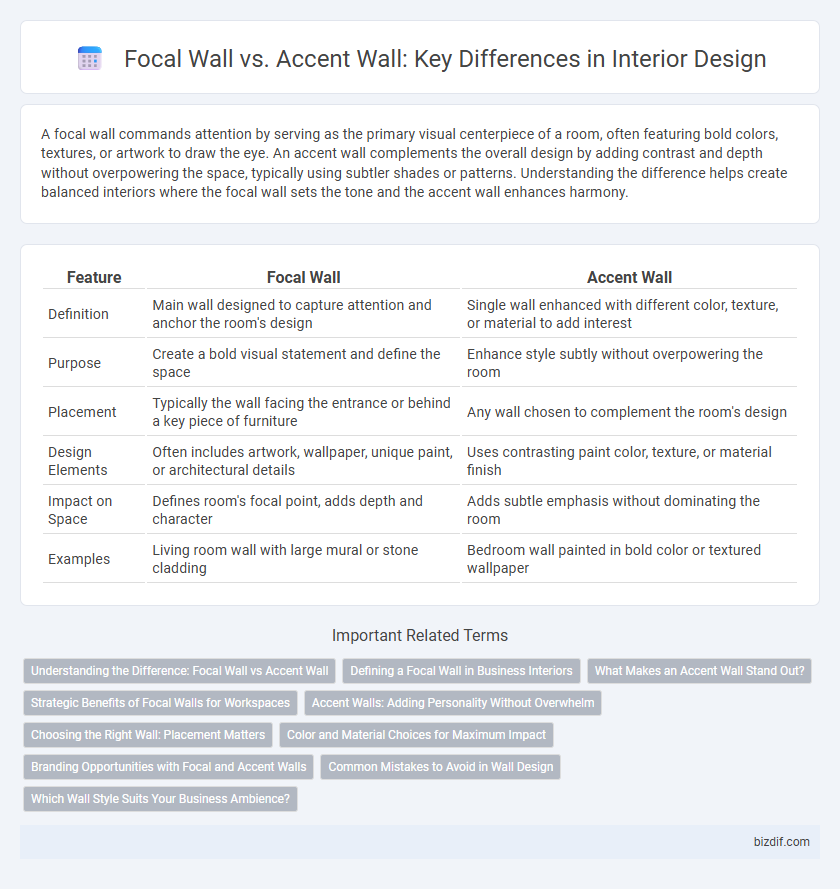A focal wall commands attention by serving as the primary visual centerpiece of a room, often featuring bold colors, textures, or artwork to draw the eye. An accent wall complements the overall design by adding contrast and depth without overpowering the space, typically using subtler shades or patterns. Understanding the difference helps create balanced interiors where the focal wall sets the tone and the accent wall enhances harmony.
Table of Comparison
| Feature | Focal Wall | Accent Wall |
|---|---|---|
| Definition | Main wall designed to capture attention and anchor the room's design | Single wall enhanced with different color, texture, or material to add interest |
| Purpose | Create a bold visual statement and define the space | Enhance style subtly without overpowering the room |
| Placement | Typically the wall facing the entrance or behind a key piece of furniture | Any wall chosen to complement the room's design |
| Design Elements | Often includes artwork, wallpaper, unique paint, or architectural details | Uses contrasting paint color, texture, or material finish |
| Impact on Space | Defines room's focal point, adds depth and character | Adds subtle emphasis without dominating the room |
| Examples | Living room wall with large mural or stone cladding | Bedroom wall painted in bold color or textured wallpaper |
Understanding the Difference: Focal Wall vs Accent Wall
A focal wall serves as the primary visual anchor in a room, drawing immediate attention through architectural features or bold design, while an accent wall complements the space by adding contrast or texture without dominating it. Focal walls often involve dramatic elements like intricate patterns or large artwork, whereas accent walls typically use color or subtle material changes to enhance ambiance. Recognizing this distinction helps interior designers strategically create balance and depth in a living space.
Defining a Focal Wall in Business Interiors
A focal wall in business interiors serves as the primary visual anchor, often featuring bold colors, textured materials, or integrated branding elements to draw attention and establish a strong identity. Unlike an accent wall, which provides subtle contrast or highlights a specific area, a focal wall commands attention and sets the tone for the entire space. Strategic placement and design of focal walls enhance customer engagement and reinforce corporate branding within commercial environments.
What Makes an Accent Wall Stand Out?
An accent wall stands out by using bold colors, unique textures, or distinct patterns that contrast with the rest of the room's decor, creating a visual focal point. Unlike a focal wall, which often highlights architectural features or structural elements, an accent wall emphasizes creativity and personal style through paint, wallpaper, or decorative materials. Strategic lighting further enhances an accent wall's impact, drawing attention to its design and elevating the overall ambiance of the interior space.
Strategic Benefits of Focal Walls for Workspaces
Focal walls in workspaces strategically enhance productivity by directing attention toward key areas, fostering clarity and organization. These walls often incorporate functional elements such as whiteboards or shelving, promoting collaboration and efficient use of space. Unlike accent walls that primarily add visual interest, focal walls serve both aesthetic and practical purposes, boosting overall workplace effectiveness.
Accent Walls: Adding Personality Without Overwhelm
Accent walls introduce personality by using bold colors, textures, or patterns to create visual interest without overwhelming the entire room. Unlike focal walls that dominate the space, accent walls complement existing decor and highlight architectural features subtly. Strategic placement of accent walls enhances depth and character while maintaining balance in interior design.
Choosing the Right Wall: Placement Matters
Choosing the right wall for a focal or accent wall depends heavily on room layout and natural light sources, as the selected wall should draw attention without overwhelming the space. Focal walls typically feature bold designs or colors on a primary wall, often the wall directly facing the room's entrance, while accent walls complement the overall decor and can highlight architectural elements like fireplaces or built-ins. Strategic placement enhances visual interest and balance, making the space feel cohesive and inviting.
Color and Material Choices for Maximum Impact
Focal walls employ bold colors and textured materials like stone or patterned wallpaper to draw immediate attention, serving as the room's centerpiece. Accent walls typically use contrasting paint hues or subtle finishes such as wood panels or fabric to complement the overall decor without overpowering the space. Strategic selection of vibrant or muted palettes combined with tactile surfaces maximizes visual interest and defines room ambiance effectively.
Branding Opportunities with Focal and Accent Walls
Focal walls create a strong visual centerpiece that reinforces brand identity by showcasing logos, key colors, or signature patterns, making them ideal for impactful brand messaging. Accent walls, while subtler, use contrasting colors or textures to highlight specific spaces, enhancing brand recognition through cohesive yet understated design elements. Both wall types strategically amplify brand presence in interior spaces, driving memorable customer experiences and reinforcing brand values.
Common Mistakes to Avoid in Wall Design
Common mistakes in wall design include confusing focal walls with accent walls, which serve different purposes; focal walls anchor the entire space visually, while accent walls complement the design without overwhelming it. Choosing overly bright colors or busy patterns for accent walls can distract rather than enhance a room, while poorly placed focal walls might disrupt traffic flow or highlight unattractive architectural features. Designers should avoid neglecting scale and proportion, ensuring wall treatments harmonize with furniture and lighting to achieve balanced aesthetics.
Which Wall Style Suits Your Business Ambience?
Choosing between a focal wall and an accent wall depends on the desired impact and brand identity of your business ambience. A focal wall serves as the main visual anchor with bold design elements, ideal for creating a strong brand statement in reception areas or showrooms. An accent wall subtly enhances the space through complementary colors or textures, perfect for maintaining a professional yet inviting atmosphere in offices or meeting rooms.
Focal wall vs Accent wall Infographic

 bizdif.com
bizdif.com